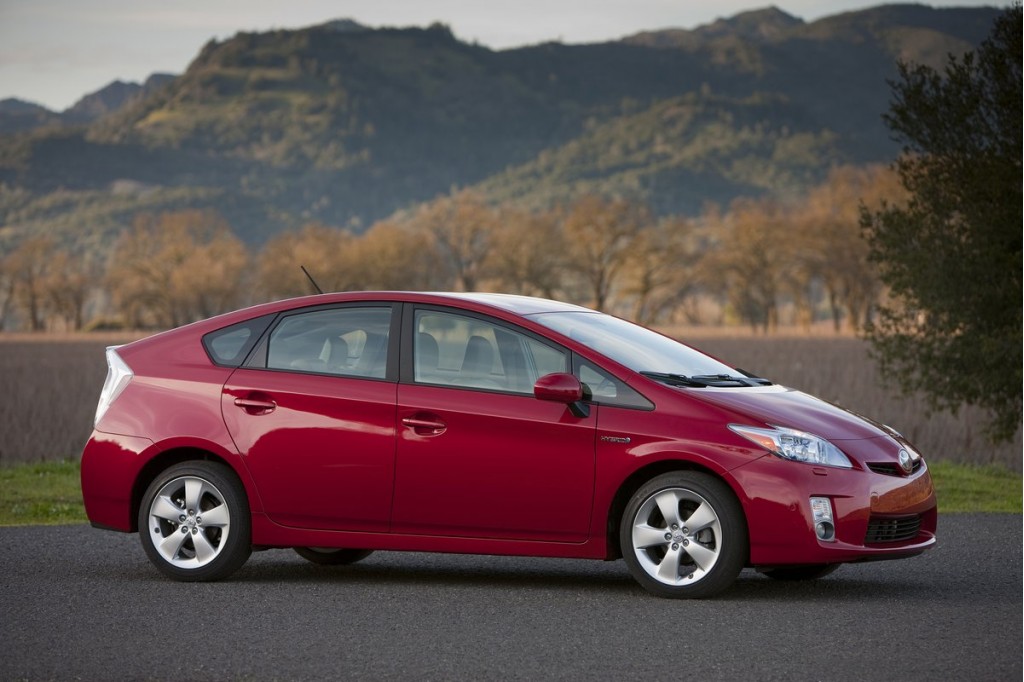Every now and then, readers write to grumble about new cars and their gas mileage.
The gist is usually something like this:
You wrote that the new 2011 [Make & Model] gets 40 mpg highway? Well, big whoop-de-doo. I always got at least 45 mpg in my 1992 Geo Metro, and it was a whole lot cheaper, so how can you say we're making progress?
The most recent note prompted us to dig up a ranking issued last summer by the U.S. Environmental Protection Agency, in which it listed the 10 most fuel-efficient cars it has tested since it began rating gas mileage in 1985. (Note that all numbers have been adjusted to its most recent test procedures.)

2011 Toyota Prius
The best-rated car today is the 2011 Toyota Prius hybrid, which has a combined rating of 50 mpg (51 mpg city, 48 mpg highway). It came second on the EPA's all-time Top 25 list.
It was edged out by the the first-generation (1999-2006) Honda Insight two-seat hybrid, with combined rating of 53 miles per gallon (49 city, 61 highway), about 6 percent better than today's Prius. The remaining eight cars in the Top 10 include no fewer than six from previous decades (and only two hybrids):
- 1986 Chevy Sprint - 44 mpg city, 53 mpg highway (48 mpg combined)
- 1990-1994 Geo Metro - 43 mpg city, 52 mpg highway (47 mpg combined)
- 1986-1987 Honda Civic CR-X - 42 mpg city, 51 mpg highway (46 mpg combined)
- 1994-1995 Honda Civic HB - 39 mpg city, 50 mpg highway (43 mpg combined)
- 2006-2010 Honda Civic Hybrid - 40 mpg city, 45 mpg highway (42 mpg combined)
- 1985 Pontiac Firefly - 39 mpg city, 47 mpg highway (42 mpg combined)
- 1985 Suzuki SA310 - 39 mpg city, 47 mpg highway (42 mpg combined)
- 2010 Honda Insight - 40 mpg city, 43 mpg highway (41 mpg combined)
So why are so few of today's cars in the EPA's Top 10? Four answers: Weight, power, safety, and features--all of which have risen substantially since the days of the Geo Metro.

2006 Honda Civic Hybrid
Weight: Today's 2011 Honda CR-Z, a two-seat hybrid sports car that is the spiritual successor to the 1983-1991 Honda Civic CR-X, weighs 2,670 pounds with a six-speed manual. The CR-X was more than 700 pounds lighter.
The weight is due to far stronger structures, for safety reasons, and a plethora of new equipment not offered in earlier cars.
Power: The CR-X of the 1980s featured a 1.5-liter four-cylinder engine that generated 91 horsepower, an underwhelming rating today. Compare that to the turbocharged 1.4-liter engine used in the 2011 Chevrolet Cruze Eco compact, rated at 138 horsepower.
The more power you pull out of an engine, the lower the fuel economy (more or less).

2000 Honda Insight
Safety: That Geo Metro had no airbags at all, with automated shoulder belts providing its only occupant protection.
By contrast, the 2011 Ford Fiesta subcompact comes with seven airbags, and the 2011 Cruze has no fewer than 10--not to mention vastly stronger structures to withstand new, much tougher NHTSA crash tests.
Features: Today's subcompacts offer features only offered on full-size luxury sedans two decades ago (or not envisioned at all back then): cruise control; air conditioning; power windows, locks, and mirrors; multi-speaker AM/FM/CD stereo systems with satellite radio; and many, many more.
Bottom Line: There's no way a car like the 1990 Geo Metro could be sold new today. It wouldn't pass modern crash-safety tests, nor meet more stringent tailpipe emissions standards, and its performance would be considered far too slow and unacceptably noisy. Then there's the Spartan interior.
In short, we've traded some of our gas mileage for nicer, safer, faster, more pleasant cars.
Would you actually buy a new 1990 Geo Metro? We don't think so.
[Kicking Tires via USA Today]













